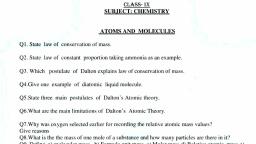Question 1 :
How many atoms are represented in$\displaystyle { Na }_{ 2 }{ CO }_{ 3 }\cdot 10{ H }_{ 2 }O$
Question 2 :
2 moles of chlorine atoms are present in_____g of chlorine gas.
Question 3 :
The chemical formula of the compound containing carbon and oxygen is :
Question 6 :
The molecular mass of $CuSO_4.5H_2O$ is:(Atomic mass of $Cu$ $=$ 63.5, $H$ $=$ 1, $O$ $=$ 16, $S$ $=$ 32)<br/>
Question 7 :
The sum of mass of all the atoms in a molecule is known as :
Question 8 :
What is the mass in grams of 3 moles of $N_2$?
Question 9 :
The relative formula mass, $M_{r}$, of calcium carbonate, $CaCO_{3}$, is $100$. What is the mass of carbon present in $100\ g$ of calcium carbonate?
Question 11 :
An element $X$ combines with oxygen to form an oxide ${X}_{2}O$. This oxide is electrically conducting. How many electrons would be there in the outermost shell of the element $X$?
Question 12 :
One mole is equal to number of atoms as contained in:
Question 18 :
The molecular mass of $(NH_4)_2CO_3$ is :Given atomic mass of H = 1, O = 16, C = 12, N = 14.<br/>
Question 23 :
The number of molecules present in $4.4$ g of $CO_{2}$ gas is:<br/>
Question 24 :
How many moles of calcium carbonate $(CaCO_3)$ are present in 20 g of the substance? ($Ca = 40,\ C = 12,\ O = 16$)
Question 25 :
Assertion: 1 g atom of $O_2$ and 1 g atom of $O_3$ have equal number of molecules.
Reason: Mass of 1 mol atom is equal to its gram atomic mass.
Question 27 :
The number of atoms in 0.1 mol of a triatomic gas is:
Question 28 :
If true enter 1, if false enter 0.<br>$12$ g carbon contains the same number of atoms as $32$ g of the sulphur has.
Question 29 :
Which of the following sample contains the maximum number of atoms?
Question 30 :
$0.75\ g$ platinic chloride of a mono-acid base on ignition gave $0.245\ g$ platinum. The molecular weight of the base is
Question 31 :
Match the column :<br/><table class="wysiwyg-table"><tbody><tr><td>Postulates</td><td>Theory<br/><br/></td></tr><tr><td>p) Atoms are divisible into three subatomic particles</td><td>i. Dalton's atomic theory</td></tr><tr><td>q) Discovery of the nucleus ( central positive charge) </td><td>ii. Modern atomic theory</td></tr><tr><td>r) Atoms are indivisible</td><td>iii. Rutherford</td></tr><tr><td>s) Position of the electron</td><td>iv.  Neils Bohr</td></tr></tbody></table>
Question 32 :
Irrespective of the source, pure sample of water always yields $88.89$ % mass of oxygen and $11.11$ % mass of hydrogen. This is explained by the law of:<br/>
Question 33 :
Identify the correct option among the following.Which of the following statements is incorrect?
Question 34 :
What is the approximate molecular mass of dry air containing 78% $N_2$ and 22% $O_2$?
Question 35 :
A gas mixture contains equal number of molecules of ${N}_{2}$ and ${SF}_{6}$, some of it is passed through a gaseous effusion apparatus. Calculate how many molecules of ${N}_{2}$ are present in the product gas for every $100$ molecules of ${SF}_{6}$.
Question 37 :
Under normal condition which of the following electronic configuration is able to form di-positive ion
Question 38 :
$5\%$ solution of sucrose is isotonic with $1\%$ solution of a compound $A$ then the molecular weight of compound $A$ is :<br/>
Question 39 :
A sample of ${ CaCO }_{ 3 }$ has $Ca=40$%, $C=12$% and $O=48$%. If the law of constant proportion is true then the weight of calcium in $5g$ of a sample of ${ CaCO }_{ 3 }$ from another source will be:
Question 40 :
A gaseous mixture contains 4.0 g of ${ H }_{ 2 }$ and 56.0 g of ${ N }_{ 2 }$. The mole fraction of ${ H }_{ 2 }$ in the mixture is:






























